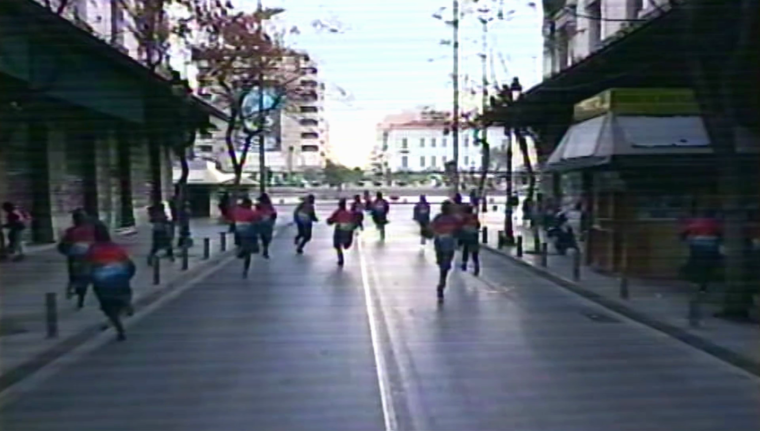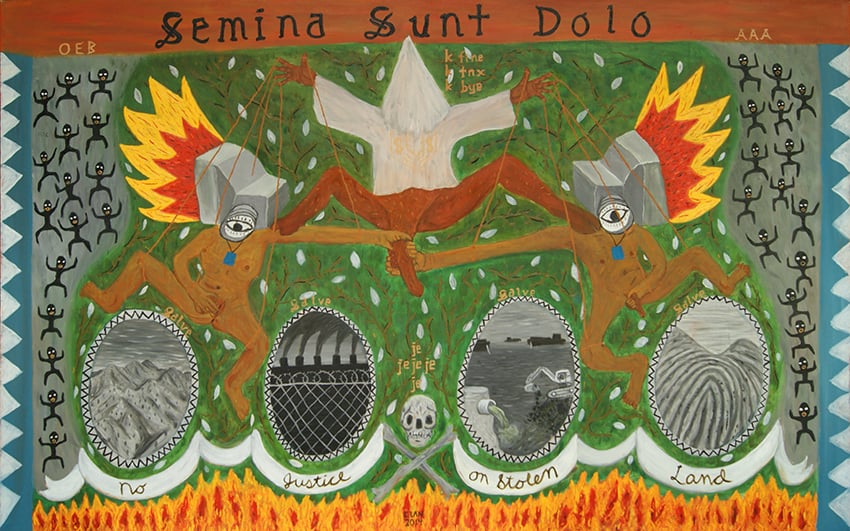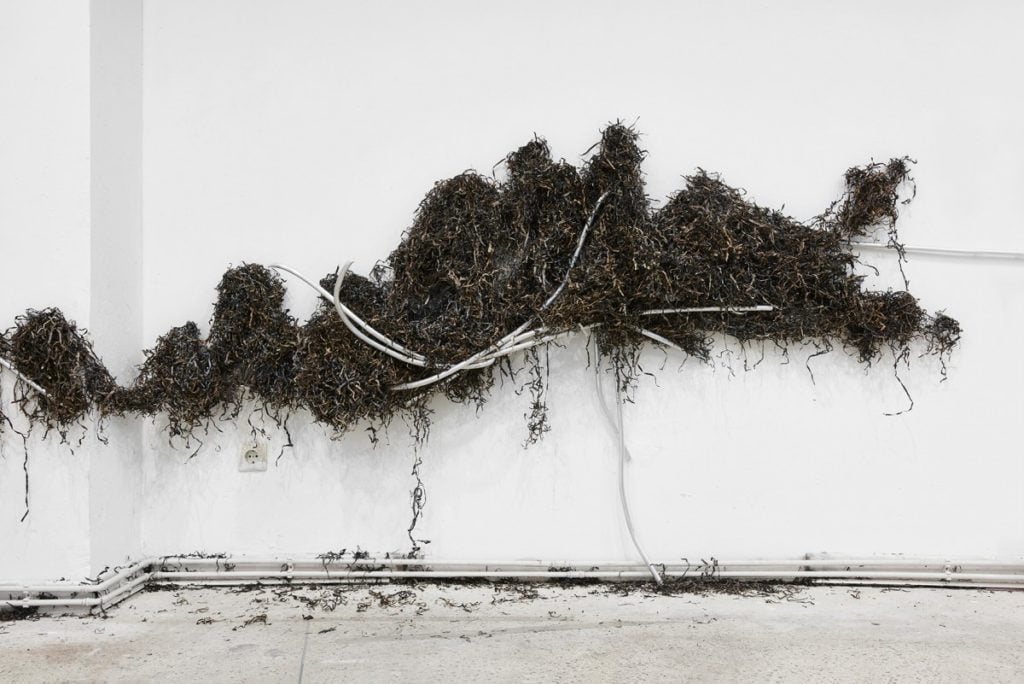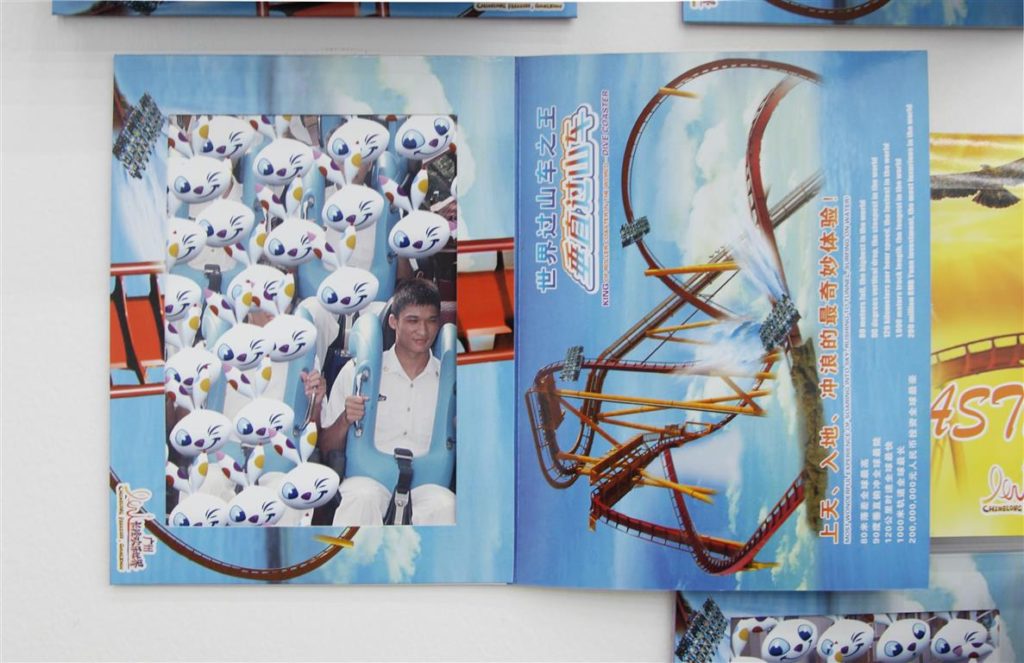Art World
What Is the Undercommons? 5 Big Ideas You Need to Know to Understand the New Museum Triennial
Yes, the New Museum's big show is heady—but we're here to help.

Yes, the New Museum's big show is heady—but we're here to help.

Ben Davis &
Caroline Goldstein

If you think the state of global affairs is grim, just wait for the charge of dejection, anger, and satire that powers the fourth edition of the New Museum Triennial. “Songs for Sabotage,” as the show is called, features a “deliberately narrow” roster of 26 artists, ranging in age from 25 to 38, and hailing from 19 countries; a scant four are US-born. Many of them have something to vent about the state of the world (and worlds to come) that is not exactly, shall we say, perky.
Organized by New Museum curator Gary Carrion-Murayari, who had helped assemble the 2010 Whitney Biennial, and Alex Gartenfeld, chief curator at the Institute of Contemporary Art in Miami, the show is packed with ideas. Some sense of its heady vibe (and House of Cards fandom?) is telegraphed by Gartenfeld in the catalogue:
’Songs for Sabotage’ proposes a species of realism that detaches from the tradition of ideological naturalism to involve the systems that define our time through (dis)connection. Globally, each of us is living through a Netflix Original remake of a once-allegorical political thriller, with the felt result being the eroding of basic freedoms and the increased suffering of already-marginalized populations.
The last Triennial, “Surround Audience” of 2015, was a new-media bacchanal. As for “Songs for Sabotage,” its research phase began in 2015, but—as the above quote indicates—it definitely aims to capture the anxious, fractious politics of this moment, worldwide. The curators speak a lot about the value of “localized gestures, actions, and dialogues” (weirdly a priority of Facebook too these days); they promise works that “serve as calls to action against the systems of domination and exploitation characteristic of global capitalism today”; most ambitiously, perhaps, they promise works that “fail to speak the universal language of global contemporary art.”
We’ve gone through the show catalogue to pick out a few of the themes and concepts that are guiding it. Below is our best shot at summarizing the big ideas you need to be hip to in order to make sense of “Songs for Sabotage.”
The term “undercommons” comes from a widely shared book by Fred Moten and Stafano Harney, The Undercommons: Fugitive Planning and Black Study, a bleak and archly anarchistic text denouncing the professionalization of knowledge within the academy.
More or less, it tries to the define the basis for new oppositional solidarities that defy easy categorization, and for forms of knowledge that resist professionalization. As Jack Halberstam explains: “For Fred Moten and Stafano Harney, we must make common cause with those desires and (non) positions that seem crazy and unimaginable.”
In the show, Carrion-Murayari and Gartenfeld let the idea of the “undercommons” give them license to look at artists who, they say, imagine “new communities centered on those whose identity, agency, and mere existence pose a threat to business as usual.”

Manolis D. Lemos, dusk and dawn look just the same (riot tourism) (still), 2017. Photo: Courtesy the artist
Thus, the Greek artist Manolis D. Lemos (b. 1989) offers a video called dusk and dawn look just the same (riot tourism) (2017) that depicts a group of undefined protestors, striding through the streets of Athens, forming and reforming in a kind of poetic image of mercurial, networked new communities of protest (or, as the catalogue rather less helpfully puts it, Lemos offers “a poetic rendition of contemporary individuation and its struggle with the power dynamics of heterodefinition.”)
And the Chinese artist Shen Xin (b. 1990), in a complex multimedia series called Provocation of the Nightingale, creates video collages of different voices colliding. The version of the video at the New Museum will be a new one, but in a previous segment, for instance, a Buddhist teacher and the head of a DNA testing service are shown debating values, then falling into an unlikely romance.
The average birth year of the artists here is 1989, making the show, in Carrion-Murayari’s words, representative of “the generation of the young precariat.”
The term is generally understood to mean the new shared reality of unstable contemporary work, encompassing day laborers, freelancers, subcontractors, part-timers, and the like. “Songs for Sabotage” more or less explicitly declares contemporary artists to be the vanguard of this new form of labor. As the philosopher Elizabeth A. Povinelli says in the catalogue, approvingly, “many cultural critics have added the international artist to the list of the wretched of the earth.”

Manolis D. Lemos, detail from “Crooked Grid Crude Carrier” (2017). Courtesy of the artist and Can Christina Androulidaki gallery, Athens.
At times, the themes of the new world of work look to be more explicit here, as with the inclusion of KERNEL (founded 2009), an art collective ruminating on the new economic realities of Greece.
Elsewhere, the show will invoke a more general, indistinct sense of precariousness and the fallenness of contemporary life: Tiril Hasselknippe (b. 1984), for instance, makes structures that resemble balconies crashed from the edifices of a collapsing civilization.
This one is notable, though not so unusual: International biennials and triennials are customarily heavy on virtuous political declaration. For their part, Carrion-Muriyari and Gartenfeld have embraced the idea of art as propaganda, claiming that contemporary politics is all about the image, so image-makers have vital roles to play in politics.
As Gartenfeld explains: “art—no matter its orientation—expresses cultural value as propaganda, and more than ever has the power to reach and reflect upon diverse constituencies in order to mobilize its contents and values.”

Haroon Gunn Salie’s History After Apartheid (South Africa) (2015). Courtesy of the artist and Goodman Gallery.
Thus, throughout, you will find work from the likes of Inhabitants, a collective founded in 2015 by Pedro Neves Marques and Mariana Silva that has created a collaborative platform for activist video; Daniela Ortiz (b. 1985), who makes “proposals for anti colonial monuments,” responding here to New York’s hotly contended statue of Christopher Columbus in Columbus Circle; or Haroon Gunn-Salie (b. 1989), who is bringing a memorial to the 2012 Marikana massacre in South Africa.
This chewy term is from Povinelli again, one of the two philosophers commissioned for the “Songs for Sabotage” catalogue. It is a bit difficult to parse: “Geontopower is a set of discourses, affects, and tactics used in late liberalism to shape the relationship between life and non-life such that it allows for the maintenance of forms of cultural and economic domination.”
In essence, “geontopower” seems to be a critical spin on the “new materialisms” that biennial curators have found so fascinating in recent years, a kind of pop-philosophical animism—”geo” meaning the physical stuff of the Earth and “onto” referring to the metaphysical state of being—that speculated on the agency of non-living things. (Remember Carolyn Christov-Bakargiev musing on the thoughts and feelings of a meteorite for documenta in 2012?)

Cian Dayrit’s Seeds of Deceit (2014). © Cian Dayrit, courtesy of Tin-aw Art Gallery.
Povinelli sees contemporary science as making it more and more arbitrary where you draw the line between life and non-life (Viruses? Artificial intelligence?); at the same time, she notes that rigid oppositions between the two have been used, historically, to discriminate against peoples who have more animistic beliefs. The implication is that one mission for contemporary artists is exposing the slippery border around what counts as alive; in the philosopher’s phrase, artists can expose “the various regions and riggings of power grids so that they can be sabotaged and hacked.”
How exactly the turn to “geontopower” plays out in “Songs for Sabotage” is not clear (Povinelli doesn’t mention examples). But an artist like the Phillipines’s Cian Dayrit (b. 1989) might offer some hints. His layered textile works look to colonial maps and the imagery of folklore and religion, remixing them in deconstructive ways to illustrate systems of classification and the political value of belief.

Violet Dennison’s Transcend (detail) (2017). Courtesy of the artist and Jan Kaps.
Then there’s the case of Violet Dennison (b. 1989), who makes tapestry-like art out of seagrass. Notably, she has flouted bans on the international transportation of plants by labeling the substance “artwork,” and that’s part of the work itself.
“Thus implicated in Dennison’s transgression,” the catalogue entry on her work explains, “the viewers joined the seagrass in a shifting symbiosis that challenged their position of primacy, apposing their claim on vitality to the generative intensity of decaying matter.” Sounds very geontopower-ful!
Which brings us to the core issue explored by the “Songs for Sabotage”: sabotage. The show, we are told, proposes it “as a model for artistic production.”
But what does that mean? Evan Calder-Williams, the preeminent theorist of the subject, offers this definition in the catalogue: sabotage, he writes, is “the deployment of a technique, or activation of a capacity, in order to challenge the apparatus or system within which it is situated.”

Song Ta, still from Who is the Loveliest Guy? (2014). Courtesy of the artist.
What does the artist-as-saboteur look like? Who Is the Loveliest Guy? by the Chinese artist Song Ta (b. 1988) presents a stunt designed to undercut the image of power. For the piece, he convinced a fearsome military unit to ride the country’s most terrifying roller coaster, capturing their reactions.
But sabotage also has a broader, artier meaning: It represents the effort, Gary Carrion-Murayari says, “to produce objects that do not satisfy futurist narratives.”
In that sense, another example may be the tapestries of St. Petersburg-born Zhenya Machneva (b. 1988), which depict, in the form of colorful tapestries, broken-down factory equipment. These offer, we are told, “a personal empathy for the process of degradation and decay”—using art to celebrate the outmoded, maybe sabotaging the very idea of art as the hot new thing.